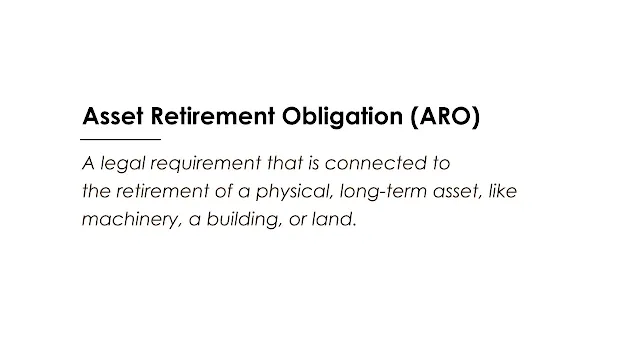 |
| Image: Moneybestpal.com |
An asset retirement obligation (ARO) is a legal requirement that is connected to the retirement of a physical, long-term asset, like machinery, a building, or land. Often, it is relevant when a business is in charge of getting rid of the object or cleaning up dangerous substances at a certain later time. In order for a company's financial statements to appropriately reflect the company's value, the ARO must be recognized by the company as a long-term asset when an obligating event occurs.
AROs serve to represent the fair worth of a legal obligation that a business assumed when it installed infrastructure assets that would eventually need to be taken down (along with remediation efforts to restore their original state). In order to avoid distorting the company's current financial position, the fair value of the ARO must be recognized right away. It must be done reliably though. AROs make a guarantee that known potential issues are anticipated and fixed. They are primarily used in the real world by businesses that frequently use infrastructure in their operations. Oil and gas firms are a good illustration.
The Financial Accounting Standards Board's Rule 143, which regulates ARO calculations, effectively states that a corporation has a legal obligation to remove the asset and that there are specific calculation guidelines for an accountant to adhere to. CPAs employ a number of techniques to determine the obligation's fair value, but the anticipated present value technique is the most popular. To use the expected present value technique, you will need the following:
- Discount Rate: The cash flows should be discounted to their present value using a credit-adjusted, risk-free rate. A company's credit standing may have an impact on the discount rate.
- Probability Distribution: We need to know the likelihood that specific events will occur in order to calculate the expected values. If there are just two conceivable outcomes, for instance, you can assume that each one has a 50% chance of occurring. Unless further information needs to be taken into account, it is advised that you adopt the probability distribution technique.
Then, you can follow the steps to calculate the expected present value of the ARO:
- Calculate the time and associated cash flows for the retirement costs in the future.
- Based on the credit standing of the company and an underlying risk-free rate, choose an appropriate discount rate. The Capital Asset Pricing Model (CAPM) can be used to determine the proper discount rate.
- Identify any variations in the ARO carrying amount from one period to the next (it is like an accretion expense).
- Any modifications to the expected cash flows' timing or quantity should be made to both the asset and the liability.
Let's look at an example of how to calculate an ARO.
A business constructs a gas station with gasoline storage in underground tanks. The tanks are expected to last 40 years (or, alternatively, the station site is leased for 40 years). The tanks will cost $15,000 to remove at this time. The business anticipates 2.5% annual inflation for this kind of labor in the future. The 9% risk-free rate (cost of borrowing) for the corporation is credit-adjusted. In 40 years, the anticipated cost to remove the tanks will be $15,000 * (1.025 x 40) = $40,275.96. This cost's current value is $1,282.29 / (1.09 x 40) or $40,275.96.
As a result, the corporation will report an ARO obligation of $1,282.29 and an increase in asset value of the same amount at the time of installation. Any suitable depreciation method will be used to amortize the asset throughout its 40-year useful life. The effective interest approach will be used to accumulate the liability over time.
The journal entry at installation is:
Debit: Asset 1,282.29
Credit: ARO liability 1,282.29
The journal entry for depreciation in year 1 (assuming the straight-line method) is:
Debit: Depreciation expense 32.06
Credit: Accumulated depreciation 32.06
The journal entry for accretion in year 1 (assuming effective interest method) is:
Debit: Accretion expense 115.41
Credit: ARO liability 115.41
The journal entry at retirement (assuming no changes in estimates) is:
Debit: ARO liability 40,275.96
Credit: Cash 40,275.96
As you can see, AROs are crucial accounting instruments that aid organizations in measuring and disclosing their legal duties connected to long-term assets. A company's activities can be more accurately valued and risked when creditors and investors are involved.
